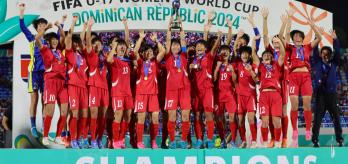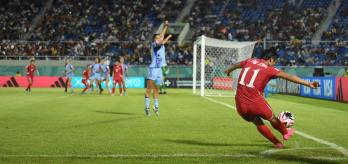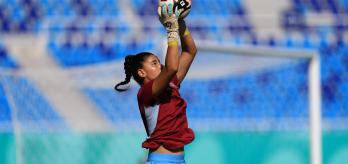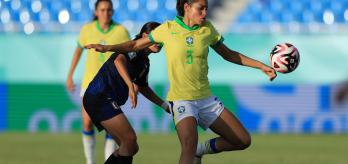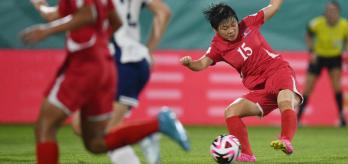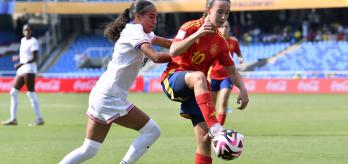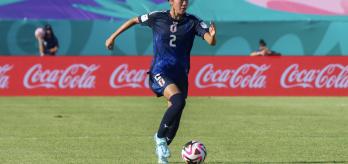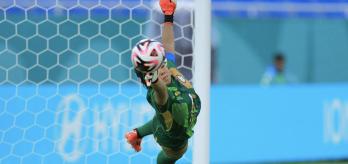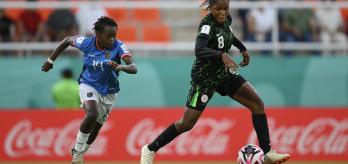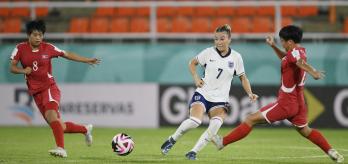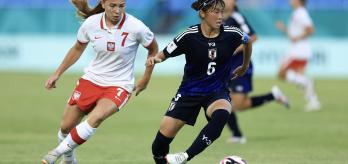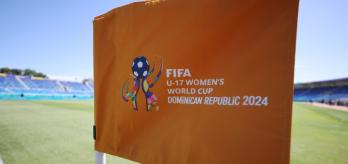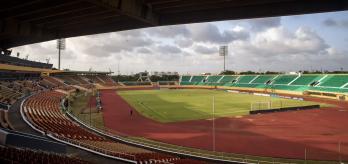Up to, and including the semi-finals of this competition, it was noted by our Football Performance Insights Team that save rates from attempts at goal on target outside the penalty area in 2024 have increased to 90.3% from 84% in 2022. In addition, there has been a significant improvement in the save rates for attempts from outside the penalty area that are aimed at the top third part of the goal, rising from 67.5% in India 2022™ to 81% in 2024.
These changes are significant and prompted an assessment of the technical differences that exist in goalkeeping when dealing with attempts at goal from different distances.
Saving attempts at goal from outside the penalty area
When aiming to save attempts at goal from outside the penalty area, it is important for the goalkeeper to be close to their goal line so that they can reduce the angle of depth for the player taking the strike at goal. Goalkeepers need to have a strong, upright posture with their hands set around their upper body because they need to have the time to be able to make a step and to push the ball with the split-second timing that is required.
The goalkeeper’s orientation in these situations is also very important and must be sympathetic to the location of the attempt at goal. For example, when the goalkeeper is facing the ball in a central position, it is far less complicated than when the attempt is coming from an angle. The majority of attempts at goal from outside the penalty area usually come from an angle and the goalkeeper’s body stance, particularly the orientation of their shoulders, is crucial in these situations. In addition, goalkeepers must consider which foot the striker of the ball will use because, with right-footed players cutting inside off the left and vice versa, this opens different angles of the goal that can affect the orientation needed from the goalkeeper.
When dealing with attempts at goal outside the area from set plays, it is a slightly different scenario for goalkeepers because they have time to evaluate the distance, the exact location of the potential strike at goal and what foot the striker of the ball is likely to use when establishing their starting position. In these situations, there is no room for speculation because once the ball is struck, there is very little time to take the step and push.
Zuberbühler has selected several clips below to highlight some of the important technical considerations as goalkeepers performing in the FIFA U-17 Women’s World Cup 2024 made saves from attempts on goal outside the penalty area.
Julia Woźniak (Poland)
Woźniak was one of the standout goalkeepers during this tournament. Her physical presence, brave mentality and strong decision-making allowed her to make a number of important saves for her team, as they advanced to the knockout stage of the competition without conceding a single goal. In clip 1 below, she makes a crucial intervention in their final group-stage match against Brazil, a game the South Americans needed to win to advance to the knockout phase.
According to Zuberbühler, “Her position here is very good because she can see the ball, and the orientation of her body is facing the angle of the ball. This is important, especially the positioning of her right foot, which is higher than her left, so she is angled towards the ball. Her body is in an upright position and her hands are braced in the ready position. This stance facilitates the save she goes on to make.
“Once the strike at goal is made, she takes a little step to her left and pushes the ball at full stretch, making a fingertip save over the crossbar. Her hand-eye coordination (ability to judge the flight of the ball so she gets her hand to the ball at the correct time) is very evident here.
"Her decision-making, strength, timing and athleticism in this situation facilitate a very important save for her team because the clean sheet guaranteed Poland progression to the knockout stage.”
Ana Morganti (Brazil)
In clip 2, we see an example from a dangerous set play situation during Brazil’s 1-0 group-stage victory over Zambia. Brazil goalkeeper Ana Morganti has a four-player wall ahead of her, but she can clearly see the ball from her starting position, which is almost two metres from her goal line. Zambia play the ball short to their left and as it moves, she takes little steps to adjust her position and orientation.
Zubi explains, “As soon as the strike at goal is about to be made, she has adjusted her position and is set, with a clear view of the ball. The ball travels quickly and she pushes strongly off her left foot, gaining maximum length with her fully stretched right arm and makes strong contact with the ball to deflect it onto the crossbar. This is a great save, and it comes from her excellent starting position, judgment and power.
Luisa Agudelo (Colombia)
Young Colombia goalkeeper Luisa Agudelo has caught the eye of our TSG with her performances in the Dominican Republic at the U-17 Women’s World Cup and in the recent FIFA U-20 Women’s World Cup 2024™ in her home nation where she also impressed. Her brave, powerful performances have made her a very influential player for her team, with a strong mentality and presence in big moments.
As Zuberbühler explains, “In clip 3 below, we see a great example of an outstanding save that she makes from a central attempt at goal. Her positioning here is close to her goal line but the power and height she generates from the standing position is really, really impressive. She pushes hard off her left foot and gets high off the ground. She extends her right arm fully and this is where the body strength, athleticism and power are evident again as she gets a strong hand to the ball to push it over the crossbar. In the replay, we see how her timing and power are so crucial here. It’s a very impressive save.
Saving attempts at goal from inside the penalty area
When making saves from attempts at goal that originate inside the penalty area, it is always important to consider the distance from goal. A situation that is 7 to 12 metres from goal is not the same as a strike at goal that is from 7 metres or less. For attempts made from 7 metres or more, the goalkeeper’s hands should be close to the ground to encourage the ball-hand connection. If the hand is close to the trajectory of the ball, it encourages the ball to be released. From this position, the goalkeeper can also project their arms and body quickly if the ball arrives high. However, if the ball comes on the ground and their hands are knee-high or above, at that moment, it is very difficult to get their hands down with any strength or explosiveness.
That is why in these situations, where the attempt at goal can come from a distance of 7 metres or more, a lower posture with their hands close to the ground is crucial for goalkeepers to make decisive stops from this range. In this situation, the goalkeeper also focuses the centre of their body weight in a slightly forward stance, on the front part of their foot, to be able to trigger their pelvic muscles to make an explosive, directional action.
When the distance is less than 7 metres, and the angle of the shot is open, the goalkeeper must close the space and make an x-block. If the angle of the shot is closed (attacker close to the end line), the goalkeeper can remain on her feet and defend any attempt, by bringing their knee close to their opposite supporting foot.
In the clips below, Zubi highlights the nuances between saving low and saving high from attempts at goal that come from inside the penalty area.
Ana Morganti (Brazil): High save from 8 metres
In this situation, Morganti can see that her defender is between the goal and the attacking player, and is in control of the situation, so she does not need to come out. As soon as her defender loses control and the striker has full possession of the ball, Morganti recognises that she is in a 1v1 situation, taking a couple of steps backwards and gets set as she knows she must defend the goal. Her right-sided centre-back comes back and tries to make an intervention but with the attacker at a range of 8 metres from goal, Morganti is in a good position.
As Zubi notes, “Because the striker is close now (within 8 metres), Morganti is correctly in a more upright position and can use an x-block or full upward extension depending on how the ball arrives. Her body position allows her to explode upwards and get a hand to the ball. This is a very good save, but the actions and alertness of her defenders here are also good once the ball is lost. One tries to make an intervention; one covers the space inside and the third tracks her opponent to the backpost area and is in a position to make an important clearance. This is good collective defending and shows that they are all connected.”
Evan O'Steen (USA): Mid-range save from 9 metres
Goalkeeper Evan O'Steen has proved to be extremely competent and involved in her team’s build-up throughout the tournament. In this situation, the USA lose the ball just outside their penalty area when attempting to play out. As soon as the attacking player advances into the penalty area with the ball under control, O'Steen immediately transitions from an offensive situation to the defensive one and adapts her tactical behaviour as such.
Zubi explains, “When the striker is around 9 metres from the goal, O'Steen’s position is great. She is set and her centre of gravity is slightly forward so she can generate power through her pelvis to react directionally. The strike at goal goes to her right side and she reacts with strength to push the ball outside her post. This is a very nice save.”
Luisa Agudelo (Colombia): Low save from 9 metres (attacking corner)
In this set play situation against the USA, there are eight players inside Agudelo’s goal area (six-yard box) and seven more inside her penalty area, so it is very important that she has as clear an overview as possible. The ball is played low into Trinity Armstrong (3) but Agudelo can see the ball and is orientated towards it.
According to Zuberbühler, “She is set, and just as the ball is struck, she adjusts and her knees are bent, ready with a slightly forward centre of gravity to react in the direction of the arrival of the ball. She reacts quickly and very explosively to get a crucial touch with her left hand to direct the ball onto her post. This is a great reaction save that comes from her body position.”
Woo Sum-in (Korea Republic): Low save from 5 metres
In this situation, Spain attacker Celia Gómez (14) breaks into the penalty area with the ball but is tracked by left centre-back Noh Si-eun (20). As goalkeeper Woo can see that her defender is present and active, she knows she can stay and defend the goal. She retreats a couple of steps to get closer to her goal and is orientated towards the ball, with a slightly forward centre of gravity in the set position at her front post when the first attempt at goal is made.
Zubi explains, “Her position when Gómez tries to play the ball towards goal is brilliant because she gets down low and can make the intervention, but her defender gets a block in. She quickly gets back on her feet and again is already set when the rebound strike at goal happens from 5 metres but, crucially, this time she is more on her heels and therefore can activate an explosive x-block and save with her right foot. These little adaptations are crucial and show she had a clear understanding of the situations she was in, and different approaches needed in the two situations.”
Key take-aways
When saving attempts at goal from outside the penalty area, goalkeepers must try to reduce the angle of depth for the striker of the ball in the following ways:
- Be as close to their goal as possible to have the time to be able to make a step and to push the ball away in the limited time available.
- The goalkeeper's orientation must be sympathetic to the location of the attempt at goal, and the context of the action which is given by the attacker's kicking foot and the orientation of her shoulders.
When saving from inside the penalty area, the location and distance from goal for the attempt is important when the goalkeeper is judging their body stance.
- For attempts made from 7 metres or more, most goalkeepers will be in a low position, with a slightly forward centre of gravity, meaning their hands are close to the ground to encourage the hand-ball connection and to trigger the hand movement, allowing them to generate directional power through their pelvic muscles.
- If the goalkeeper's centre of gravity is behind them, they will be forced to initiate the move with their lower body and make a save with one of their feet.





